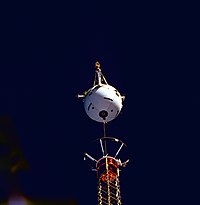
Photo from wikipedia
Abstract Interface properties and bias temperature instability (BTI) determine the performance and stability of SiC metal-oxide semiconductor (MOS) devices. In this work, we propose an electron cyclotron resonance microwave nitrogen–oxygen… Click to show full abstract
Abstract Interface properties and bias temperature instability (BTI) determine the performance and stability of SiC metal-oxide semiconductor (MOS) devices. In this work, we propose an electron cyclotron resonance microwave nitrogen–oxygen (N O) mixed plasma post-oxidation annealing (POA) process to improve the interface properties and BTI of 4H-SiC MOS capacitors. Results showed that the N O mixed plasma POA reduces the density of interface traps, maintains the stability of the flat band voltage (Vfb) hysteresis under four successive cycles of positive bias temperature stress (PBTS) and negative bias temperature stress (NBTS) at 423 K, and significantly reduces the Vfb hysteresis under alternating PBTS and NBTS at 100 K. The oxide traps remarkably decreased to 2.27 × 1012 cm−2 after N O mixed plasma POA. The related passivation and improvement mechanisms were further studied by secondary ion mass spectroscopy, X-ray photoelectron spectroscopy, and density functional theory calculations. The synergistic effects of highly reactive N and O plasma promoted the considerable absorption of N at the interface and prevented further oxidation of the SiC substrate. We also elaborate on the effects of N, O, and N O plasma on the elimination and passivation of O vacancy defects, C-related defects (SiOxCy and C dimer), and Si interstitial defects and discuss implications of the simultaneous suppression of electron and hole trapping.
Journal Title: Applied Surface Science
Year Published: 2020
Link to full text (if available)
Share on Social Media: Sign Up to like & get
recommendations!